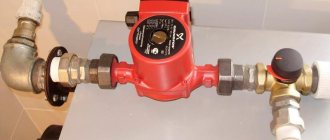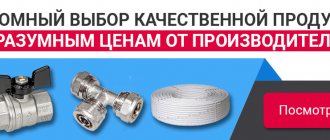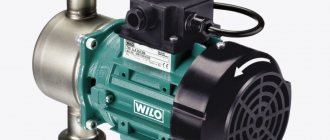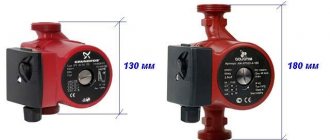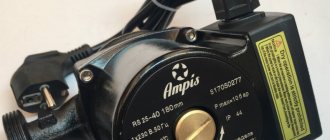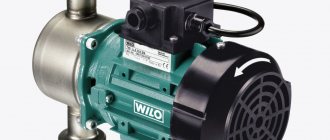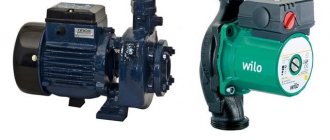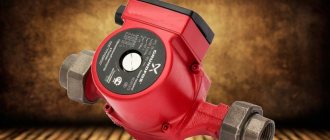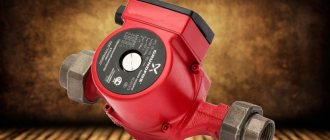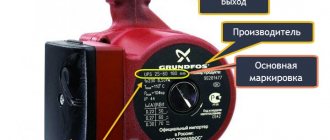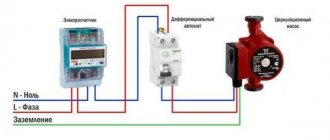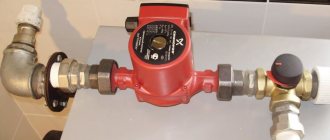Is it necessary, and in what cases?
Many owners of country real estate, and especially two-story houses, are interested in the question of installing an additional circulation pump in the heating system. They come to this conclusion after uneven heating of the radiators in the rooms, provided that the boiler has sufficient power. If the temperature difference between the boiler and the coolant in the pipelines exceeds 20 degrees, then it will be necessary to remove air plugs or set the existing pump to an increased speed.
Installation of additional pumping equipment is necessary in the following cases:
- When adding an additional circuit to the heating system, and especially when the pipe length exceeds 80 meters;
- For uniform movement of coolant in pipelines.
An additional pump in the heating system may not be needed if it is balanced using balancing and control valves, so before purchasing additional equipment, bleed the air from the radiators and add water to the system. If everything works fine, then there is no point in installing an additional pump.
Pump location in the heating circuit
The pipes through which the system is filled are installed in front of the pump and equipped with ball shut-off valves. Installing pressure gauges will make it easier to control pressure.
How to assemble the circuit correctly:
- a threaded fitting with a diameter corresponding to the size of the ball stop valve is placed on the pipe section;
- plastic pipes are joined using a soldering device, and metal-plastic pipes are joined using a compression fitting.
- then install the ball shut-off valve, attach the filter, install the circulation pump using couplings, then the second valve and fitting.
- a valve for releasing air is included in the harness.
- Each connection is sealed with Fum tape or waterproof sealants with tow (tape).
- LiveJournal
- Blogger
Pump diagram on a heating system
An open heating system with a circulation pump requires placing an expansion tank at a height. With a closed structure, it is placed near the boiler and membrane tank.
Hydraulic separator
If there is a need to install an additional pump, then another device must be included in such a heating system - a hydraulic separator. In the list of terms used, a hydraulic separator can also be called an anuloid or a hydraulic arrow.
Where to put
In the autonomous heating system of a private house, it is recommended to install circulation pumps with a wet rotor, which rotate without the use of special lubricants. The coolant and lubricating element here are the coolant. When installing such a device, the following rules must be taken into account:
- The pump shaft must be in a horizontal position relative to the floor surface;
- The movement of water flow in the system must coincide with the direction of the arrow on the device;
- To prevent liquid from entering the pump terminals, the box should be installed on the top or side of the equipment.
Correct installation of an additional pump in the home heating system
According to some users, it is better to install the pump on the return pipeline. Here the coolant temperature is minimal, which will increase the service life of the device, but not all experts agree with this statement. The fact is that the pump is designed for operation in a coolant environment whose temperature can reach 110 degrees.
Determining where to insert the pump
The optimal solution to the problem of heating a house is to install an electric heating boiler with a pump integrated into the design. The efficiency of the new equipment reaches 98 - 99%, with low energy consumption. Control of the automatic system is not complicated, and additional configuration is rarely required. The unit allows you to provide hot water supply.
- LiveJournal
- Blogger
Such a device will speed up the heating of the heater (battery).
Installation of a circulation pump into a heating system from separate parts is carried out taking into account the technical parameters of all devices, their compatibility, determining the correct position of each of them relative to the surface of the floor, walls and each other.
Installation diagram
In practice, two schemes for installing a circulation pump are used in a single-pipe and two-pipe heating system. Before carrying out installation work, you must carefully study the attached instructions. At the preparatory stage of work, water is drained from the system and the pipes are cleaned of contamination by additional pumping of liquid. The pump is installed according to the attached diagram, then coolant is poured into the circuit and the unit is turned on.
As we have already said, it is best to install the pump on the return side using a tap or, as it is also called, a bypass. Such a device is necessary to shut off the water and replace the pump in case of breakdown. The diameter of the outlet pipe should be smaller than that of the central pipeline.
Installation diagram of an additional pump in the heating system
At each edge of the bypass, before entering and after exiting the pump, taps are installed for emergency shut-off of the coolant. Another valve is installed on the central line to direct the flow of liquid through the pump. Before entering the pumping equipment, a special filter is attached that will accumulate harmful particles in the water.
Installation rules
The main components of the heating system: boiler, membrane expansion tank, circulation pump, radiators, coupling valve, gas valve, alarm devices. It is necessary to have a mesh filter, a water supply branch, controls, temperature and emergency sensors.
When determining the location of the structure, the main condition is to ensure free access to the unit and electrical network devices, as well as to connect the grounding. Other Important Pump Installation Conditions
- “Wet” models should be positioned only horizontally, so that the rotor is completely immersed in water.
- Versatile equipment of the device with ball shut-off valves for maintenance, repair, dismantling.
- Installing a protective filter in front of it.
- The bypass is equipped with a built-in valve to remove air plugs.
- Hermetic serial connection of threaded elements of the system.
The instructions included with each device contain the basic rules for installation and operation. Exact fulfillment of all conditions will extend the life of the structure and ensure uninterrupted supply of coolant.
With warm floor
When filling the system with coolant, it is not always possible to get rid of the air present here. Accumulated gases often block the movement of fluid, and not every manifold can be used as a relief valve. To solve this problem, the circulation pump has a special outlet valve made in the form of a disk.
To release accumulated gases, you need to turn this part with a screwdriver counterclockwise. After supplying water from the slot, the disk is tightened and the pump is started again. A similar procedure is repeated several times in a row.
Circulation pumps are installed in heating systems with forced or natural circulation. It is needed to increase heat transfer and to be able to regulate the temperature in the room. Installing a circulation pump is not the most difficult task; if you have a minimum of skills, you can do it yourself, with your own hands.
Why do you need a bypass?
The installation of a circulation pump in the heating system is carried out in the presence of electricity. To ensure that the water supply does not stop during a power outage, the pump is mounted on a bypass, blocking its inlets with ball shut-off valves. Open and close the fittings along the edges of the bypass when turning the device on and off, directing the water flow in the required direction. In cold weather, the pump is turned on and the coolant is released into the bypass pipe. In summer (or without power supply), the liquid flows by gravity through a straight pipe.
What is a circulation pump and why is it needed?
A circulation pump is a device that changes the speed of movement of a liquid medium without changing pressure. In heating systems it is installed for more efficient heating. In systems with forced circulation it is a mandatory element, in gravity systems it can be installed if it is necessary to increase the thermal power. Installing a circulation pump with several speeds makes it possible to change the amount of heat transferred depending on the outside temperature, thus maintaining a stable temperature in the room.
Cross-section of a circulation pump with a wet rotor
There are two types of such units - with a dry and wet rotor. Devices with a dry rotor have a high efficiency (about 80%), but are very noisy and require regular maintenance. Units with a wet rotor operate almost silently; with normal coolant quality, they can pump water without failure for more than 10 years. They have a lower efficiency (about 50%), but their characteristics are more than sufficient for heating any private home.
Standards for installing gas mounted boilers
There are regulations that specify construction rules for installation.
When installing, be sure to follow the standards. Photo source: strmnt.com
First you will have to fulfill all the conditions specified in these documents:
- Call the gas workers so that the specialists check the existing conditions and, if the rules are followed, allow the connection of the unit to the central main line of the house.
- Draw up the project correctly to avoid a fine. An exception is that the heat generator has already been installed in the house and you only need to replace it with an identical model.
As soon as the project is completed, it is necessary to contact the state supervision authorities with papers. After checking, they issue permission to install a wall-mounted boiler.
Then you need to fulfill a few more mandatory conditions - choose the right height and comply with the requirements. security.
Height
When installing the boiler on the wall, you must follow the rules for selecting the optimal height specified in the SP. It says that from the floor to the bottom of the purchased boiler the distance should be 0.9 meters (minimum), but not more than 1.2 meters
It is important to note that these parameters are used for boilers, but gas manufacturers often make these requirements for boilers as well
It is important to comply with the minimum height established by gas workers, which is calculated by the distance from the chimney pipe. Official regulations indicate that a wall-mounted device will have to be lowered by 2 diameters (minimum value) of the chimney
The permissible limits for installing a heat generator are 0.8-1.8 from ground level.
Fire safety standards for installation
Equipped boiler room.
Photo source: th360.ru When installing a wall-mounted gas boiler in an apartment, it is necessary to comply with industrial safety standards.
Therefore, it is necessary to set fire breaks (minimum indicators that should be adhered to are indicated):
- The distance from the equipment to the wall is at least 10 cm.
- From the opposite wall - at least 40 cm.
The fire safety rules clearly state that a thermal insulation shield must be installed on the equipment, attaching it to the wall. It must be located immediately under the gas boiler. If you have to install a chimney through the roof, then it is also necessary to install fire breaks.
It is necessary to install a protective non-combustible partition between the room with a single-circuit wall-mounted boiler and the residential part. It must have an increased degree of fire resistance for the safety of household members. When connecting equipment, it is necessary to use a corrugated metal pipe. It is strictly forbidden to purchase rubber hoses for boiler installation.
Where to put
It is recommended to install a circulation pump after the boiler, before the first branch, but on the supply or return pipeline it doesn’t matter. Modern units are made from materials that can withstand temperatures up to 100-115°C. There are few heating systems that work with a hotter coolant, so considerations of a more “comfortable” temperature are untenable, but if you feel safer, put it in the return line.
Can be installed in the return or direct pipeline after/before the boiler up to the first branch
There is no difference in hydraulics - the boiler, and the rest of the system; it makes absolutely no difference whether there is a pump in the supply or return branch. What matters is the correct installation, in the sense of strapping, and the correct orientation of the rotor in space. Nothing else matters.
Harness
There are two types of heating systems - forced and natural circulation. Systems with forced circulation cannot work without a pump; systems with natural circulation work, but in this mode they have lower heat transfer. However, less heat is still much better than no heat at all, so in areas where electricity is often cut off, the system is designed as hydraulic (with natural circulation), and then a pump is installed into it. This gives high heating efficiency and reliability. It is clear that the installation of a circulation pump in these systems is different.
All heating systems with heated floors are forced - without a pump, the coolant will not pass through such large circuits
Forced circulation
Since a forced circulation heating system without a pump is inoperative, it is installed directly into the gap in the supply or return pipe (of your choice).
Most problems with the circulation pump arise due to the presence of mechanical impurities (sand, other abrasive particles) in the coolant. They can jam the impeller and stop the motor. Therefore, a mesh dirt filter must be placed in front of the unit.
Installing a circulation pump in a forced circulation system
It is also advisable to install ball valves on both sides. They will make it possible to replace or repair the device without draining the coolant from the system. Turn off the taps and remove the unit. Only that part of the water that was directly in this piece of the system is drained.
Natural circulation
The piping of the circulation pump in gravity systems has one significant difference - a bypass is required. This is a jumper that makes the system operational when the pump is not working. One ball shut-off valve is installed on the bypass, which is closed the entire time the pumping is running. In this mode, the system operates as forced.
Installation diagram of a circulation pump in a system with natural circulation
When the electricity goes out or the unit fails, the valve on the jumper is opened, the valve leading to the pump is closed, and the system operates as a gravity system.
Installation features
There is one important point, without which the installation of the circulation pump will require rework: it is necessary to rotate the rotor so that it is directed horizontally. The second point is the direction of flow. There is an arrow on the body indicating which direction the coolant should flow. This is how you turn the unit so that the direction of movement of the coolant is “in the direction of the arrow”.
The pump itself can be installed both horizontally and vertically, just when selecting a model, make sure that it can work in both positions. And one more thing: with a vertical arrangement, the power (pressure created) drops by about 30%. This must be taken into account when choosing a model.
Electrical connection options
An electric pump for heating has the only drawback: in the event of an emergency power outage, the circulation will stop, so it is necessary to design the system with the expectation of additional use of the natural flow of coolant.
The pump box is equipped with three contacts, marked as phase, ground, zero, which are connected to the socket with a cable and plug, or the cable line from the meter runs directly to the device. Manually starting the device increases energy consumption, wear of the mechanism and parts, so it is better to make the connection to electricity automatic - through a thermostat.
The advantage of using a thermostat is the regulation of the switching time: the pump of the Wilo heating system starts working only when the water is heated, and does not allow cold water to run idle.
Operating principle: the thermostat is attached to the pipe, measures the temperature of the heat pipe, and starts the mechanism of the unit.
If it was not possible to buy a device special for pipes, you can connect the circulation pump to electricity using a room household thermostat, which has an external temperature measurement sensor attached to the pipe.
In the absence of electricity, use a backup UPS source that provides uninterrupted power to the heating pump: car batteries, or a set of batteries in a compact cabinet.
The connection follows the following diagram: the home electricity line is connected to the UPS, then connected to the pump and boiler. Connection conditions:
- Do not allow the power cable to come into contact with hot parts of the device - motor, housing, pipe;
- Avoid wetting the terminal box;
- if the box is on the side, connection is allowed from below;
- the cable must be heat-resistant;
- be sure to ground.
If you equip the pipe with a thermostat, energy losses during pump operation will be reduced.
Selecting the right unit
To ensure long-term uninterrupted operation of the system, it is better to entrust the selection of equipment to a professional technician.
- low energy consumption,
- durability,
- uniform heat distribution,
- noiselessness,
- automatic regulation of maximum and minimum pressure,
- sufficient water flow in the heating system.
To do this, it is necessary to calculate the following parameters: the total length of the system line, the material and diameter of the pipes. Take into account the type of heating units and quantity, types of control and shut-off equipment, automation characteristics. The heating circulation pump, which has the function of regulating the frequency and speed of the rotary shaft, is characterized by reduced energy consumption, noiselessness, and durability. An automatic change in the speed occurs when the temperature of the water (glycol mixture) decreases or increases. Retrofitting the device with air vents eliminates the problem of air locks.
Among the many models, professional craftsmen call a popular, cost-effective, low-noise device a Wilo circular pump (Wilo Top and Wilo-Stratos), which has a wet rotor installed inside the coolant pipeline. The low weight of the device allows it to be mounted on the pipe surface without additional supports. The models are high-performance, universal: suitable for any heating system. Popular domestic units are linear units TsVTs, Livgidromash.
Choose a heating pump model that has two or three operating modes, and through testing you will find the optimal option for heating the room.
Approximate circulation calculation: for an area up to 250 sq. m. – the circulated volume of water is 3.5 cubic meters. m. per hour, at a pressure pressure of 0.4 atm.
Increasing the area to 350 sq. m. requires 4.5 cubic meters. m per hour and 0.6 atm.
If the area exceeds 350 sq. m, close to 800 sq. m. you need permission up to 10 cubic meters. m., at 0.8 atm.
When the room in the house is larger, it is necessary to install an additional pump in the heating system.
The correct installation of the pump influences the smooth functioning of the device.
Unlike private houses, where water supply, gas supply, and heating depend on the entrepreneurial spirit of the owner, apartment buildings are “fully provided by the state.” Connecting to central networks frees residents from developing an individual project, purchasing appropriate equipment, and carrying out large-scale work. However, utility services do not always cope with their responsibilities, and apartment owners have to “help” them. For example, install pumps to increase pressure in pipes.
Types of pumps for apartments
Pumps for apartments can be divided into two large groups - for water supply and heating.
Water supply pumps increase the pressure in water pipes and increase the pressure. Heating devices increase the circulation rate of the coolant, which ensures uniform heat distribution throughout the entire system in a single apartment.
Of course, a pump is needed for a comfortable life. But his installation is not a whim, but a necessary measure. In what cases is this equipment needed?
• If the water pressure does not allow you to run a bath • You can take a shower or wash dishes only late at night, when all the neighbors are asleep and do not turn on the water • The pressure in the pipes is not enough to operate a washing machine, dishwasher, gas water heater or boiler • If the apartments are on the upper water does not reach the floors at all • When the risers are hot and the heating radiators are lukewarm
Let's take a closer look at each type of pump for apartments
Pressure booster pump
Do you know what water pressure standards are accepted for an apartment building?
According to SNiP 2.04.2-84 and SNiP 2.04.02-85, according to which water supply systems are designed, the following standards apply: • from 0.3 to 6 atmospheres - cold water • from 0.3 to 4.5 atmospheres - hot water
These are extreme values, exceeding which, when measured and recorded with a pressure gauge, is a reason for complaints to the management company and recalculation of payments for utilities.
Go ahead. According to the same regulations, the following pressure is considered sufficient for sanitary and household appliances: • 0.2 atmospheres - washbasin and faucet • 0.3 atmospheres - bathtub and faucet • 0.3 atmospheres - shower cabin • 0.2 atmospheres - flush toilet • 0.3 atmospheres - bidet • 4 atmospheres - jacuzzi and hydromassage equipment
2 atmospheres - washing machine • 1.5 atmospheres - dishwasher • from 1.5 to 2.5 atmospheres - heating boiler
In practice, especially in old buildings, Khrushchev-era buildings, and socket buildings, a decrease in pressure to 1.5-1 atmosphere is recorded. And these are not the first floors. Residents of 5 floors and above during peak hours - in the mornings and late evenings - are left without water at all or are forced to settle for a thin trickle from the tap. Which is not enough for a full life.
A water pressure booster pump is designed to solve these problems. It is a compact small device that fits into a water supply pipe and operates on a pressure principle. On average, such a pump is capable of increasing pressure by 1.5-2 atmospheres. It all depends on the power of the chosen model and the needs of the family.
The pressure requirement is calculated based on the number of family members, taps installed in the apartment, as well as plumbing and household equipment.
Pumps differ in several parameters:
Control type - manual and automatic
The hand pump is controlled by the owner. It costs less, but is difficult to use. We depend on when it was turned on and off, and it will work even if it is not currently being used for its intended purpose. So, during the washing process, the machine draws water periodically, and the pump will consume electricity for the entire cycle - an hour, two or more.
The automatic pump is equipped with sensors and turns on only when the tap opens and water flows. Does not require control, economical. Equipped with dry-running protection, it automatically turns off if there is no water in the system or an accident occurs.
By cooling method - “dry” and “wet”
“Wet” is the cooling of the pump by the flowing liquid itself. “Dry” - cooling using a built-in fan. The first type is more compact and operates almost silently. The second is structurally larger, but is characterized by high reliability and performance.
In addition, pumps differ in power, permissible temperature, and pipe cross-section. When choosing equipment, it is these technical characteristics that people pay attention to first.
When installing a pump to increase water pressure, several points are important: • It is recommended to install a filter at the inlet of the pump - this way you will extend the life of the equipment • High-quality sealing of the connections between the pump and the pipeline is required • For installation, select a dry, heated room with free access (especially for models with manual control) • Move the shut-off valve on the pipe to the pump installation location
If the situation is critical not only with the pressure, but also with the availability of water on the upper floors in general, a simple pump will no longer help. We will talk about an entire pumping station, the design of which includes a hydraulic accumulator. Thanks to its high power, the pumping station is able to lift water from the lower tiers of the house to the upper floors and provide sufficient pressure for hygiene procedures and for the operation of several household appliances at once.
A centrifugal pumping station pumps water from the water supply system first into a storage tank, and from there it forcefully pushes it to the outlet points. When the tank is full, the pump turns off and then turns on again when empty. Depending on the volume of the tank, water can be used for a certain time without using system resources. Accordingly, the larger the volume, the less often the station will have to be turned on, and the less electricity it will consume.
The difficulty in installing a pumping station lies in its size. It is not enough to embed this equipment into a pipe; the technology here is more complicated. To place the station you will need a room that meets the parameters. Yes, not everyone will like the noise of “pumped” water. However, the choice between a little discomfort and full water supply is obvious.
Heating circulation pump
Designed for installation in apartments on the upper floors and in old buildings, where due to poor circulation the radiators remain cold.
Heating pump: • Increases the rate of heating of pipes • Ensures uniform heating even over large areas • Eliminates the formation of air locks in pipes • Stabilizes pressure and protects the internal system from water hammer
Modern pumps, equipped with automation and a control panel, can be installed in almost any convenient location in the system. The main thing is that this place is constantly accessible for adjusting the pump operating parameters, checking the sealing of the connection and regular inspection. Experts recommend connecting the pump to the bypass. In the future, if the equipment has to be removed or replaced, dismantling will not affect the functioning of the heating system.
The nuances of installing pumps in apartments and the legal aspect
Before purchasing and installing a pump, it is necessary to identify the true cause of low pressure and cold batteries. But it may turn out to be a banal blockage, which the apartment owner can eliminate on his own. If cleaning the pipes does not lead to anything, the next step is to check the condition of the neighbors’ networks. A similar situation in a neighbor’s premises is a reason to contact the management company with a complaint. The management company is obliged to come with an inspection, take measurements and record the pressure gauge readings. Next, you should check the condition of common building communications and carry out preventive or repair work.
In fact, this takes more than one month, and in the most severe cases, more than one year. They will tell you about worn-out networks and refer to an upcoming major overhaul. But water is needed here and now, and not in 5 years.
If there is no reason to expect mercy from utility companies, here are 2 options for breaking the deadlock:
First. Hold a meeting of residents and jointly install one powerful pump on the common house system. Then everyone will be happy.
Second. Install a pump or pumping station only in your apartment. So that everything is according to the law, and your neighbor does not blame you in the future for the lack of water and all mortal sins, coordinate the installation of pumping equipment with the resource supplying organization - Vodokanal and the Management Company. To carry out installation work, invite local mechanics or engineers and sign an official document.
Installation of a pump - as a process of reconstruction, changing utilities - must be carried out in accordance with all the rules. Well, or at your own peril and risk, if you are ready to bear responsibility for the possible consequences.
If you are going to install a pump in the near future, then you simply need high-quality sealing materials. You can buy them directly from the manufacturer on our website.
